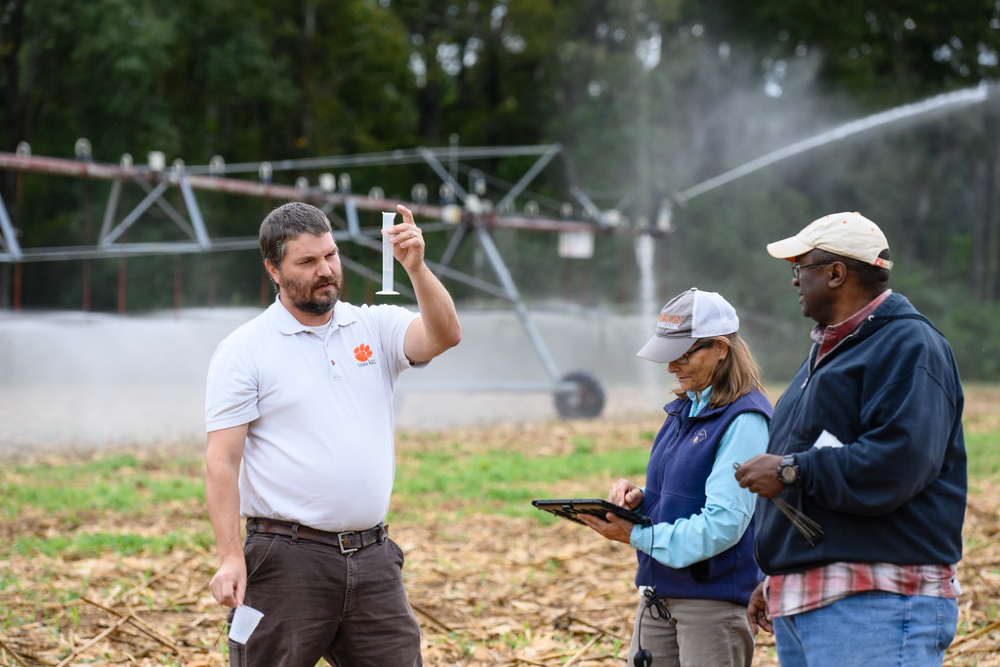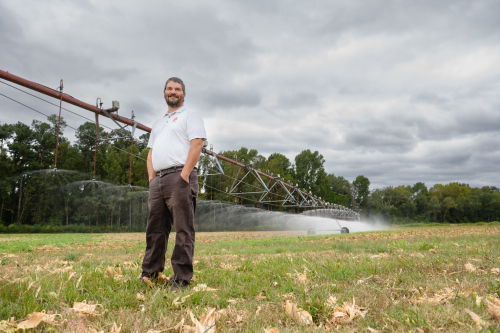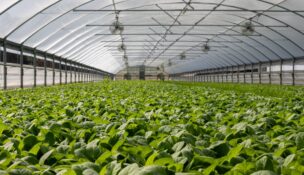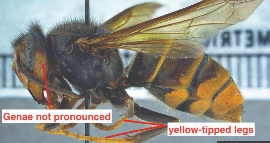How technology is reshaping South Carolina’s agribusiness industry
Krys Merryman //November 22, 2022//
How technology is reshaping South Carolina’s agribusiness industry
Krys Merryman //November 22, 2022//

Kendall Kirk, precision agriculture engineer and director of Clemson University Center for Agricultural Technology, didn’t grow up around agriculture — but now it’s his passion.
“Planting food plots for deer hunting was the closest I got, before I came to Clemson,” said Kirk.
Kirk said he didn’t really know much about the industry, until he stumbled upon the agriculture program at Clemson as an undergraduate student in 1998. From there, he started studying aquaculture engineering research for his master’s degree and Ph.D. and began teaching in 2005 in the agriculture and business program.
“Since I didn’t grow up around it [agriculture], I felt it was crucial to surround myself with people who did,” Kirk said.
In 2014, he started research at the Clemson University Edisto Research and Education Center as a precision agriculture engineer, focusing on research and extension.
“I love the people,” he said. “A lot of my passion for the industry comes from learning about the things I don’t know, and I love learning from other people. What they see in a problem and/or solution I didn’t see. It’s a fun community to work with, farmers, agriculture industry, etc. People in the industry are passionate about what they do and aware of their strengths and the people around them, making it easy to work in and build a collaborative environment.”
Technology has begun reshaping South Carolina’s agribusiness industry in recent years, allowing for an efficient productivity, which benefits people on a global scale. And Clemson is on the front lines, launching in August its Center for Agricultural Technology, which focuses on education, outreach and research with the goal of positively impacting global food supply, farmers’ productivity and agricultural sustainability — locally, regionally and globally.
Staff, faculty, and students at the center, headquartered at Edisto REC in Blackville, S.C., collaborate with private and public partners to create, develop, and enhance solutions for the agriculture industry through testing and evaluating precision agriculture technologies and other digital solutions for the industry while enhancing accessibility to these solutions.
“I recognize everyone at the center comes to the table with different gifts, and within that, the work we are doing and trying to support is intended to be multidisciplinary, reaching across college boundaries to bring people together who can contribute to the solution,” said Kirk. “At the heart of that ecosystem, the things that the industry and academia do well come together to develop agricultural technologies even quicker.”
The South Carolina General Assembly finalized in the 2022-23 fiscal year budget $750,000 to integrate agricultural technology development, said Kirk, which has helped their program a great deal.
“Their investment represents recognition of South Carolina farmers and its citizens, and is a testament and confidence in Clemson’s ability to deliver on that return-on-investment, providing additional support for ongoing work that’s already being done,” he added.
Technology’s impact on agriculture
Technology has changed the agricultural landscape in South Carolina — and globally — by increasing the production per unit input, said Kirk. For example, things like money, labor, water, fertilizer, real estate and more. Though the addition of technology in the industry requires more specialization and training in agriculture support workforce, the results in reduced environmental impact per unity is vital.
Technology has also allowed for a deeper understanding of effects of in-field variability such as yield and soil mapping, with improved management of in-field variability such as zone and grid sampling and remote sensing, according to Kirk.
“Recently, technology in the agricultural space, when we think about it, we aren’t thinking about tech in terms of tools and machines necessarily but the electronics behind them,” said Kirk. “There is more to it than screens. I am always emphasizing keeping boots on the ground and not becoming too reliant on tech, because there still needs to be a human aspect to it. Technology is only as good as what we program into it.”
Electronic traceability has also been improving for years. For example, the ability to rapidly know not only where a shipment of watermelon came from but also what field on that specific farm, when it was harvested, what harvest crew harvested it, and in a matter of seconds versus weeks or more of tracing down a paper trail, according to Kirk. Food safety and disease outbreaks such as listeria has also improved through traceability, so those issues are better addressed and the known causes, leading to faster recalls if necessary.
Tech-driven solutions often allow agriculture producers to maximize outputs relative to input, allowing for more efficiency. This directly translates to reduced environmental impacts from agriculture and improved long-term sustainability of food, fiber, and fuel production, said Kirk.
U.S. residents generally spend a smaller fraction of their income on food than most of the rest of the world, according to Kirk.
 “This means, we have more resources available to advance our education, contribute to good causes, and generally increase our quality of life in the way of an improved environment,” he added. “A large part of this stems from successes in agricultural productivity. Tech-driven improvements will be required to stay on the leading edge of agricultural productivity and security.”
“This means, we have more resources available to advance our education, contribute to good causes, and generally increase our quality of life in the way of an improved environment,” he added. “A large part of this stems from successes in agricultural productivity. Tech-driven improvements will be required to stay on the leading edge of agricultural productivity and security.”
As for the economic impact of improving technology in the agriculture industry, maximizing existing resources use efficiency is key, said Kirk. For example, it’s as simple as conserving and cutting down on energy and water use, so there will be more resources of such available to South Carolinians while also cutting down on labor.
These technological developments also serve to create new opportunities in the industry, because South Carolina is positioning itself to be a leader in agricultural technology development, and industry collaboration in that space will bring industry leaders to the state to do their work and begin new ventures, Kirk said.
“With these new ventures will come new jobs and opportunities for South Carolinians,” he added. “We are looking at the big picture, the global impact. As we become more efficient in production, the cost of everything we produce will go down, making each thing more competitive in the spaces they work in.
“We spend less of our income on our food than anywhere else in the world. When our agriculture productivity can make more for less then that trickles down to everybody.”
l
















